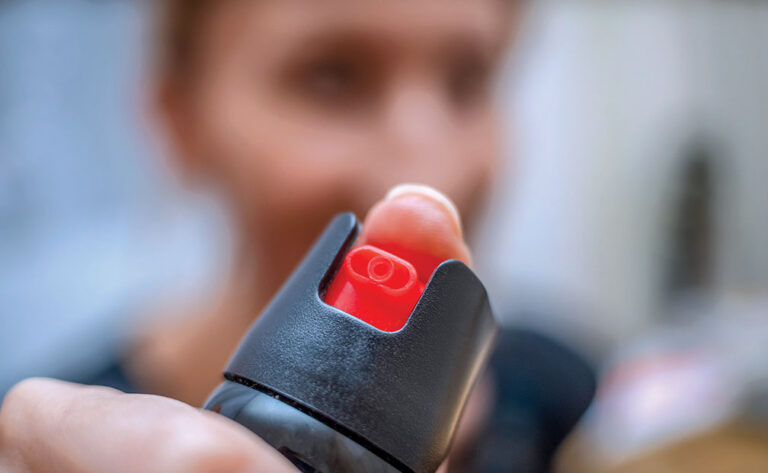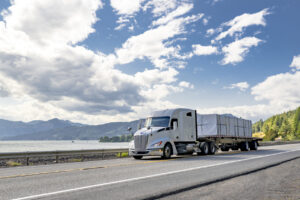Trucking can take you to some scary places — and it often seems that the places where trucks park don’t offer enough in the way of protection. Drivers often have little choice about where they park, especially near cities, where parking spaces are likely to be occupied early in the evening.
The first, and often best, form of security is to use the obvious strategies: Lock your doors and keep your windows rolled up. Some drivers use a strap to pull the doors towards each other in case the locks are defeated.
Before leaving your truck, use the windows and mirrors to inspect the area around your vehicle to make sure no one is lurking in wait. Park in well-lit areas when possible. Don’t “nose-dive” into a space; instead, back in or pull through so the cab of your truck isn’t secluded in the darkness. Choose spaces as close to the restaurant or C-store as possible.
Whenever you’re out of the truck, remain diligent about the area around you. Just as you maintain a constant eye scan when you’re driving, do the same while you’re walking. Pay attention to other people you see. Don’t be distracted by electronics — leave the cellphone in your pocket or purse.
Unfortunately, even your best diligence won’t prevent some criminals from getting too close. For that reason, many drivers carry weapons of one sort or another. Firearms are a popular choice — but they are as likely to create a problem as they are to get you out of one. Even if open- or concealed-carry are legal in the state where you live, you may be traveling through states where it is illegal to carry a firearm at all. In addition, even in states that allow firearms, individual counties or municipalities may prohibit weapons. Some have severe penalties, and the weapon may be confiscated as well.
There are alternatives to firearms for personal protection, but keep in mind that any device that could cause bodily harm could potentially run afoul of the law. Another possibility is that an injured assailant could initiate civil action against you should you injure them during the assault. Even if you win, the expenses for travel, court costs and lost work can add up.
Still, those risks may pale when compared to the specter of being injured (or worse) by an assailant.
The least risky (and likely the least effective) method of personal protection is to carry a noisemaking device that, in theory, draws attention to you and your attackers, causing them to break off an attack because of unwanted witnesses. A whistle is the simplest form of noisemaker, but there are also battery-powered versions that can be quite loud. Some noisemakers have flashing lights to help attract the attention of others.
Some drivers prefer to carry items that are usually standard equipment for an OTR trucker, like tire thumpers or hammers, that can be used for self-defense. Others choose knives ranging from plain pocketknives to larger, more deadly ones. Any of these can be effective deterrents but come with a danger — you’ll need to get close to make them work. There’s always the possibility that they can be taken and then used against you.
Truncheons or batons can be expandable and are small enough to fit in a purse or pocket when collapsed, but long enough to do damage when extended. Some large, heavy flashlights are sold as “tactical” that can be used as striking devices. Some of these flashlights have rough surfaces or edges designed to inflict greater damage, and some even contain small cavities designed to collect enough tissue to be used for DNA testing.
Some tactical flashlights have another feature, a strobe function that’s designed to confuse or disorient the attacker with a series of bright flashes or alternating patterns of light. Again, to be effective, you must be close to your assailant.
One interesting device is the self-defense, or security, umbrella. Self-defense umbrellas are made with a stout center shaft and a hefty handle. They can be used in a stabbing motion or used as a striking weapon — with the added benefit of keeping you dry in the rain. They are stout enough to be used as a cane, as well.
Stun devices have the same issue. They can be effective, but you need to be close enough to press the device against an attacker. There is maintenance involved as well; you’ll need to make sure batteries are fresh and the device is working.
There are non-lethal options that let you protect yourself at a distance, although there are limits to any of them. Teargas or pepper sprays can be effective, especially if sprayed in an attacker’s eyes, but they have limited range. An assailant with a strong will, possibly enhanced by drugs, may not be stopped by these devices; however, in most cases they will work. Some drivers recommend keeping cans of insecticide designed to kill wasps and hornets in the truck. It’s cheap, shoots farther than pepper spray and can be effective — but remember, these products contain poisons and are designed to kill insects. They can potentially cause blindness or permanent damage when used on a human being.
Tasers are an option used by many law enforcement agencies as an effective, non-lethal weapon that can incapacitate an attacker for 30 seconds or more. They work by shooting two small probes into the target and then applying electricity to disable muscular function. The range depends on the device; some can shoot as far as 50 feet while others only reach 10 feet or so.
Finally, there are weapons that use compressed carbon dioxide capsules to propel balls filled with teargas, pepper gel or other irritants. Some, such as the product made by Byrna, are shaped like pistols and function in much the same way, but they are brightly colored to avoid confusion. The Byrna shoots .68 caliber balls hard enough that the impact alone can be a deterrent.
Other, similar devices are essentially designed for paintball. They shoot pepper balls or kinetic (hard rubber) balls. Many launchers look much like pistols, and an attacker may think you’re carrying the real thing.
Many of these devices can be purchased from Amazon or your favorite sporting goods store.
Cliff Abbott is an experienced commercial vehicle driver and owner-operator who still holds a CDL in his home state of Alabama. In nearly 40 years in trucking, he’s been an instructor and trainer and has managed safety and recruiting operations for several carriers. Having never lost his love of the road, Cliff has written a book and hundreds of songs and has been writing for The Trucker for more than a decade.













